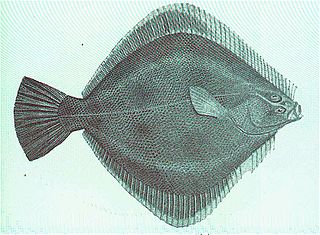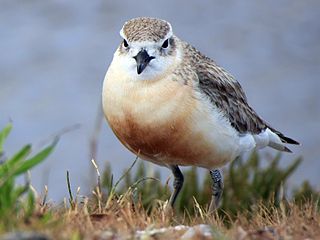
The black sea bass is a species of marine ray-finned fish, a sea bass from the subfamily Serraninae which is part of the family Serranidae, which also includes the groupers and anthias. It is found in the western Atlantic Ocean, where it is an important species for commercial and recreational fisheries.

The common dab is an edible flatfish of the family Pleuronectidae. It is a demersal fish native to shallow seas around Northern Europe, in particular the North Sea, where it lives on sandy bottoms down to depths of about 100 metres (330 ft). It can reach 40 centimetres (16 in) in length and can weigh up to 1 kilogram (2.2 lb), though most specimens grow no longer than 20 centimetres (7.9 in).

The New Zealand sand flounder is a righteye flounder of the genus Rhombosolea, found around New Zealand in shallow waters down to depths of 100 m.

The winter flounder, also known as the black back, is a right-eyed ("dextral") flatfish of the family Pleuronectidae. It is native to coastal waters of the western north Atlantic coast, from Labrador, Canada to Georgia, United States, although it is less common south of Delaware Bay. It is the most common near-shore (shallow-water) flounder in the waters from Newfoundland down through Massachusetts Bay, reaching a maximum size around 61 cm in length and 2.25 kg in weight. The species grows larger on Georges Bank, where they can reach a length of 70 cm and weight of 3.6 kg. Although winter flounder historically supported large commercial and recreational fisheries, biomass and landings have decreased since the 1980s.

The dark fruit-eating bat, is a bat species from South America.

The European flounder is a flatfish of European coastal waters from the White Sea in the north to the Mediterranean and the Black Sea in the south. It has been introduced into the United States and Canada accidentally through transport in ballast water. It is caught and used for human consumption.

The Kamchatka flounder, Atheresthes evermanni, is a flatfish of the family Pleuronectidae. It is a demersal fish that lives at depths of between 20 metres (66 ft) and 1,200 metres (3,900 ft). Its native habitat is the temperate waters of the northern Pacific. It can grow as long as 100 centimetres (39 in) in length, and can weigh up to 8.5 kilograms (19 lb).

Pseudopleuronectes is a genus of righteye flounders mostly native to the northwestern Pacific Ocean with one species found in the northwestern Atlantic Ocean.

The New Zealand brill, Colistium guntheri, is an edible flatfish of the family Pleuronectidae. It is a demersal fish native to shallow seas around New Zealand, at depths of between 27 metres (89 ft) and 49 metres (161 ft). It can grow to 91 centimetres (36 in) in length and can weigh up to 1.8 kilograms (4.0 lb).
The peppered flounder is a flatfish of the family Paralichthodidae and the only species of the genus Paralichthodes. It is a demersal fish that lives on sandy and muddy bottoms in subtropical waters, at depths of up to 100 metres (330 ft). Its native habitat is the southeastern Atlantic and the western Indian Ocean, specifically the African coastline from Mossel Bay, South Africa, to Delagoa Bay, Mozambique. It grows up to 50 centimetres (20 in) in length.

The rex sole is a flatfish of the family Pleuronectidae. Locally, it may also be known as a witch or threadfin sole. It is a demersal fish that lives in temperate waters on sand or mud bottoms at depths of up to 900 metres (3,000 ft), though it is most commonly found between 61 and 500 metres. Its native habitat is the northern Pacific, from Baja California in Mexico up the coasts of the United States, British Columbia and Alaska, across the Bering Sea to the coast of Russia and the Sea of Japan. It is slow-growing, reaching up to 60 centimetres (24 in) in length, and it can weigh up to 2.0 kilograms (4.4 lb). Maximum reported lifespan is 24 years.

The ridged-eye flounder, also known as the frog flounder, is a species of flatfish in the family Pleuronectidae. It is a demersal fish that lives on sand and mud coastal bottoms at depths of between 2 and 170 metres. Its native habitat is the temperate waters of the north-western Pacific, from southern Hokkaido to the Korean peninsula, the Bohai Sea, the Yellow Sea and the South China Sea. It can grow up to 30 centimetres (12 in) in length, and can weigh up to 1 kilogram (2.2 lb).
Cirripectes obscurus, the gargantuan blenny, is a species of combtooth blenny considered endemic to coral reefs in the Hawaiian island chain.It's perhaps the largest and most colorful of the Hawaiian blennies.

The Arctic flounder, also known as the Christmas flounder, eelback flounder and Polar plaice, is a flatfish of the family Pleuronectidae. It is a demersal fish that lives on coastal mud bottoms in salt, brackish and fresh waters at depths of up to 90 metres (300 ft). Its native habitat is the polar waters of the northeastern Atlantic and Arctic oceans, from the White and Barents seas to the coasts of Siberia in Russia and Queen Maud Gulf in Canada, and from the Chuckchi and Bering seas to Bristol Bay in Alaska and the northern Sea of Okhotsk. It can grow up to 35 centimetres (14 in) in length.
The yellow striped flounder, Pseudopleuronectes herzensteini, is a flatfish of the family Pleuronectidae. It is a demersal saltwater fish that occurs in the temperate waters of the northwestern Pacific, from the Sea of Japan to the Kuril Islands, Sakhalin, Korea, the Yellow Sea, Gulf of Bohai and the East China Sea. It can grow up to 50 centimetres (20 in) in length, though commonly it reaches around 28.5 centimetres (11.2 in); its maximum recorded weight is 1.3 kilograms (2.9 lb) and its maximum reported lifespan is 15 years.
The cresthead flounder is a flatfish of the family Pleuronectidae. It is a demersal fish that lives on bottoms in salt water in the temperate waters of the northwestern Pacific, from the southern parts of the Sea of Okhotsk and the Kuril Islands to Korea and northern Honshu, Japan. It can grow up to 50 centimetres (20 in) in length, though it more commonly reaches lengths of around 32.5 centimetres (12.8 in). Its maximum recorded weight is 2.5 kilograms (5.5 lb).

The marbled flounder, Pseudopleuronectes yokohamae, is a flatfish of the family Pleuronectidae. It is a demersal fish that lives on saltwater sand and mud bottoms. Its natural habitat is the temperate coastal waters of the northwestern Pacific, from southern Hokkaido, Japan, to the Yellow Sea, Gulf of Bohai, East China Sea and Korean Peninsula. It can grow up to 45 centimetres (18 in) in length, and its maximum recorded weight is 1.9 kilograms (4.2 lb).

The comb flounder is a flatfish of the family Pleuronectidae. It is a demersal fish that lives on saltwater bottoms at depths of between 20 and 406 metres. Its natural habitat is the tropical waters of the western Indian Ocean, from KwaZulu-Natal and Mozambique in Southern Africa, to coastal Tanzania and Kenya in the African Great lakes region, to Somalia in the Horn of Africa, to Karnataka and Maharashtra in India. It can grow up to 19 centimetres (7.5 in) in length.
The narrow-body righteye flounder is a flatfish of the family Pleuronectidae. It is a demersal fish that lives on saltwater bottoms at depths of between 218 and 438 metres. Its natural habitat is the waters of the Indo-West Pacific, from the Bali Strait to Northern Territory, Queensland and New South Wales in Australia. It can grow up to 15 centimetres (5.9 in) in length.

The northern New Zealand dotterel or northern red-breasted plover is a shorebird which breeds exclusively on beaches in New Zealand's North Island.














